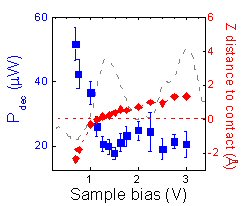15:00-16:00
Scanning tunnelling microscopy and spectroscopy as a tool to study transport properties through single molecules and molecular nanostructures
Dr.Katharina J. Franke(Freie Universitat Berlin, Germany)
-
Non-linear transport properties through organic molecules on an inorganic substrate are substantial in the rapidly evolving field of molecular electronics. In order to preserve the molecular characteristics a weak coupling to the metallic electrodes is required. Such environments are usually created by depositing organic molecules on thin insulating films which are grown on metallic surfaces. We show that the combination of two molecular species yields the capability of steering the intermolecular interactions such that they dominate over the bonding to a metallic surface and hence yield a means of reducing the coupling without the use of additional spacer layers.
Using scanning tunnelling microscopy and spectroscopy we investigate C60 in a hierarchy of self-assembled nanostructures with tetraphenyladamantane (TPA). The basic building block is a triangular shaped tetramer composed of three TPA surrounding a fullerene (cf. Fig.1). The strong interaction between the two molecular species leads to a reduction of the electronic coupling of the C60 to the substrate. A characteristic of such weak coupling is a regime of negative differential conductance in the tunnelling spectra. Additionally, we find C60 molecules which are adsorbed on top of rows of alternating C60 and TPA. Their electronic fingerprint is a very sharp resonance revealing an even higher degree of decoupling from the surface followed by a broad vibronic sideband. Decoupled molecules thus represent an ideal system for studying electron-phonon coupling, as the electron lifetime reaches the order of magnitude of vibrational relaxation times.
Another clear expression of electron-phonon coupling during transport is the heating of the molecule. Electron current generates heat in the molecular junction and eventually leads to thermal decomposition of the molecule. The power for decomposition varies with electron energy and reflects the resonance structure participating in the transport. When the STM tip contacts the fullerene the molecule can sustain much larger currents revealing molecular cooling by vibrational decay into the tip upon contact formation.
 |  |
| Fig.1: STM image of a molecular tetramer consisting of C60 surrounded by three TPA molecules. | Fig.2: Power for molecular decomposition of C60 molecules as a function of sample bias. It reflects the molecular resonance structure (dashed line) and a strong increase when a tip-molecule contact is formed. |








